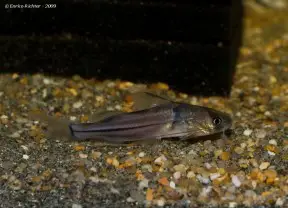Brachyrhamdia meesi
Classification
Order: Siluriformes Family: Heptapteridae
Distribution
Type locality is ‘near Belem, Brazil’, i.e., the city of Belém near the mouth of the Amazon River in Pará state. It’s precise distribution is unclear, however, with one record pertaining to the Río Madre de Dios basin, several thousand kilometres from Belém in southeastern Perú.
Maximum Standard Length
The largest officially-recorded specimen measured 61 mm.
Aquarium SizeTop ↑
Base dimensions of 80 ∗ 30 cm or equivalent.
Maintenance
A substrate of fine sand is ideal, and the tank can be further-decorated with driftwood roots and branches. Although aquatic plants aren’t likely to be a feature of its natural habitat species from genera such as Microsorum, Taxiphyllum, Cryptocoryne and Anubias may survive attached to items of décor.
It’s intolerant to the accumulation of organic wastes and requires spotless water at all times in order to thrive, therefore a stringent regime of weekly partial water changes and aquarium maintenance should be employed.
Water Conditions
Temperature: 24 – 28 °C
pH: 6.0 – 7.5
Hardness: 18 – 179 ppm
Diet
Brachyrhamdia spp. feed mostly on benthic invertebrates in nature. In the aquarium live and frozen foods such as Artemia, Daphnia and chironomid larvae (bloodworm) should be offered regularly although sinking dried foods are also accepted.
Behaviour and CompatibilityTop ↑
Generally non-aggressive although very small fishes might be eaten. There’s no need to keep this species alongside a group of Corydoras (see ‘notes’).
Brachyrhamdia spp. are not especially gregarious with conspecifics but more than one can usually be maintained provided the aquarium is not too small.
Sexual Dimorphism
Mature females should be noticeably fuller in the body than males.
Reproduction
Unrecorded, but spawning of B. imitator has been observed and was apparently initiated by a group of cohabiting Corydoras melanistius which began to spawn just prior to the Brachyrhamdia.
NotesTop ↑
This species is rare in the aquarium hobby and normally imported only as bycatch among shipments of other fishes, particularly Otocinclus spp. It can be told apart from the similar-looking B. marthae by possession (vs. absence) of a dark vertical bar running through the eye.
Several Brachyrhamdia species have developed colour patterns that mimic syntopically-occurring Corydoras spp. throughout the life-cycle, and the remainder, including B. meesi, may mimic Otocinclus or smaller Corydoras spp. when juvenile. They’re easily told apart from Corydoras by their significantly longer barbels and lack of scute-like plates on the body.
Among other catfishes they’re closely-related to members of the genus Pimelodella, but differ in that the posterior cranial fontanelle is closed and forms two small foramina whereas in Pimelodella it is wide open.
The family Heptapteridae was previously considered a subfamily (Rhamdiinae) of the family Pimelodidae, but molecular studies appear to have confirmed its monophyly. It’s most closely-related to the familes Pimelodidae, Pseudopimelodidae, and the genus Conorhynchos.
References
- Ferraris, C. J., Jr., 2007 - Zootaxa 1418: 1-628
Checklist of catfishes, recent and fossil (Osteichthyes: Siluriformes), and catalogue of siluriform primary types. - Sullivan, J. P., J. G. Lundberg and M. Hardman, 2006 - Molecular Phylogenetics and Evolution 41: 636-662
A phylogenetic analysis of the major groups of catfishes (Teleostei: Siluriformes) using rag1 and rag2 nuclear gene sequences.


